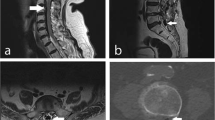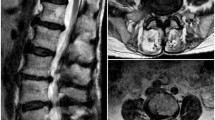Abstract
Introduction
Pneumorrachis is presence of air in the epidural space. It could be the result of trauma, barotrauma, iatrogenic or spontaneous. The pneumorrachis per se is an underdiagnosed entity as most of the patients are asymptomatic or have subclinical symptoms. The spontaneous occurrence of pneumorrachis has been reported in literature but giant spontaneous occurrence causing cauda equina syndrome has not been reported so far.
Case presentation
We report a case of 56-year-old male patient who came to our OPD on wheelchair with complains of difficulty in walking for 6 months with dribbling of urine for 2 months with on and off back pain. His perianal sensation was reduced with absent voluntary anal contraction. Imaging revealed giant air pockets in the spinal canal of L5-S1 extending upto L4-L5. It was managed surgically wherein laminectomy without fusion was done. The patient responded well to the treatment.
Discussion
There are many causes of pneumorrachis described in literature. Most of the cases of pneumorrachis are asymptomatic and incidentally diagnosed. With the improvement in radio-diagnostic modalities, the diagnosis of pneumorrachis can be easily established. When symptomatic, they can be managed conservatively. Those presenting with neurological deficit may require surgical intervention or other invasive intervention.
This is a preview of subscription content, access via your institution
Access options
Subscribe to this journal
Receive 1 print issues and online access
We are sorry, but there is no personal subscription option available for your country.
Buy this article
- Purchase on Springer Link
- Instant access to full article PDF
Prices may be subject to local taxes which are calculated during checkout



Similar content being viewed by others
Data availability
The authors confirm that the data supporting the findings of this study are available with the article and its Supplementary Material. Raw data that support the findings of this study are available from the corresponding author upon reasonable request.
References
Oertel MF, Korinth MC, Reinges MH, Krings T, Terbeck S, Gilsbach JM. Pathogenesis, diagnosis and management of pneumorrhachis. Eur Spine J. 2006;15:636–43.
Gordon IJ, Hardman DR. The traumatic pneumomyelogram. A previously undescribed entity. Neuroradiology. 1977;13:107–8.
Goh BK, Yeo AW. Traumatic pneumorrhachis. J Trauma. 2005;58:875–9.
Hwang WC, Kim HC. CT demonstration of spinal epidural air after chest trauma. Eur Radiol. 2000;10:396–7.
Kakitsubata Y, Inatsu H, Kakitsubata S, Watanabe K. CT manifestations of intraspinal air associated with pneumomediastinum. Acta Radiol. 1994;35:305–6.
Jarolimek AM, Harris JH Jr. Pneumorachis. Emerg Radiol. 1999;6:146–8.
Oertel MF, Korinth MC, Truong HT. Pneumorrhachis. Neuroradiology. 2004;46:S171.
Pedicelli G, De Santis M, Mattia P. Pneumorachis following asthma-induced barotrauma CT recognition of an unusual manifestation of life-threatening asthma. Eur Radiol. 1997;7:S100.
Yoshimura T, Takeo G, Souda M, Ohe H, Ohe N. CT demonstration of spinal epidural emphysema after strenuous exercise. J Comput Assist Tomogr. 1990;14:303–4.
Cayli SR, Koçak A, Kutlu R, Tekiner A. Spinal pneumorrhachis. Br J Neurosurg. 2003;17:72–4.
Chiba Y, Kakuta H. Massive subcutaneous emphysema, pneumomediastinum, and spinal epidural emphysema as complications of violent coughing: a case report. Auris Nasus Larynx. 1995;22:205–8.
Chibbaro S, Selem M, Tacconi L. Cervicothoracolumbar pneumorachis. Case report and review of the literature. Surg Neurol. 2005;64:80–2.
Chimon JL, Cantos EL. CT recognition of spinal epidural air after pelvic trauma. J Comput Assist Tomogr. 1990;14:795–6.
Kennedy TM, Ullman DA, Harte FA, Saberski LR, Greenhouse BB. Lumbar root compression secondary to epidural air. Anesth Analg. 1988;67:1184–6.
Mallick A. Air in the epidural space leading to a neurological deficit. Anaesthesia. 2003;58:292–3.
Miguel R, Morse S, Murtagh R. Epidural air associated with multiradicular syndrome. Anesth Analg. 1991;73:92–4.
De Oliveira GS Jr, Charchaflieh J, Walega D Jr. Pneumorrhachis mimicking meningitis after a paramedian lumbar interlaminar injection. Clin J Pain. 2011;27:355–6.
Gracia J, Gomar C, Riambau V, Cardenal C. Radicular acute pain after epidural anaesthesia with the technique of loss of resistance with normal saline solution. Anaesthesia. 1999;54:168–71.
Paik NC, Lim CS, Jang HS. Cauda equina syndrome caused by epidural pneumorrhachis: treatment with percutaneous computed tomography-guided translaminar trephination. Spine. 2013;38:E440–3.
Stevens R, Mikat-Stevens M, Van Clief M, Schubert A, Weinstein Z. Deliberate epidural air injection in dogs: a radiographic study. Reg Anesth Pain Med. 1989;14:180–2.
Overdiek N, Grisales DA, Gravenstein D, Bosek V, Nishman R, Modell JH, et al. Subdural air collection: a likely source of radicular pain after lumbar epidural. J Clin Anesth. 2001;13:392–7.
McCarthy MJ, Aylott CE, Grevitt MP, Hegarty J. Cauda equina syndrome: factors affecting long-term functional and sphincteric outcome. Spine. 2007;32:207–16.
Dhatt S, Tahasildar N, Tripathy SK, Bahadur R, Dhillon M. Outcome of spinal decompression in cauda equina syndrome presenting late in developing countries: case series of 50 cases. Eur Spine J. 2011;20:2235–9.
Author information
Authors and Affiliations
Contributions
KB has designed the study, gathered information and did the final proof reading, AG gathered information, MG gathered information and made the case report.
Corresponding author
Ethics declarations
Competing interests
The authors declare no competing interests.
Ethical approval
Informed written consent obtained from the patient.
Additional information
Publisher’s note Springer Nature remains neutral with regard to jurisdictional claims in published maps and institutional affiliations.
Rights and permissions
Springer Nature or its licensor (e.g. a society or other partner) holds exclusive rights to this article under a publishing agreement with the author(s) or other rightsholder(s); author self-archiving of the accepted manuscript version of this article is solely governed by the terms of such publishing agreement and applicable law.
About this article
Cite this article
Gupta, A., Guha, M. & Bansal, K. A rare case of spontaneous giant pneumorrachis presenting with cauda equina syndrome: a case report. Spinal Cord Ser Cases 10, 18 (2024). https://doi.org/10.1038/s41394-024-00631-8
Received:
Revised:
Accepted:
Published:
DOI: https://doi.org/10.1038/s41394-024-00631-8



